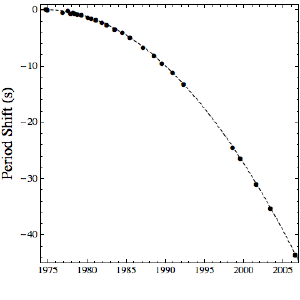Post
Spirals
8 August 2013
A while back I wrote about how general relativity predicts gravitational waves. While we haven’t yet observed gravity waves directly, we know they exist. That’s because gravitational waves carry energy away from their source, just as light waves carry light energy.
When two stars orbit each other, they produce gravitational waves. The gravity waves in turn take away some of the energy from the binary system. This means that the two stars gradually move closer together, an effect known as inspiralling. As the two stars inspiral, their orbital period gets shorter (because their orbits are getting smaller). Eventually they become so close that they merge, usually creating a supernova or black hole.
 Brian Koberlein
Brian KoberleinFor regular binary stars this effect is so small that we can’t observe it. However in 1974 two astronomers (Hulse and Taylor) discovered an interesting pulsar. You may remember that pulsars are rapidly rotating neutron stars that happen to radiate radio pulses in our direction. The pulse rate of pulsars are typically very, very regular. Hulse and Taylor noticed that this particular pulsar’s rate would speed up slightly then slow down slightly at a regular rate. They showed that this variation was due to the motion of the pulsar as it orbited a star. They were able to determine the orbital motion of the pulsar very precisely, calculating its orbital period to within a fraction of a second. As they observed their pulsar over the years, they noticed its orbital period was gradually getting shorter. The pulsar was inspiralling, and would eventually merge with its companion star in about 300 million years.
In the figure above, I’ve plotted the measured orbital periods of pulsar with the theoretical period shortening due to gravity waves, based on data gathered by Joel Weisberg and Joe Taylor.1 As you can see, the data lines up almost exactly. The system is losing energy just as general relativity predicts. Hulse and Taylor were awarded the Nobel prize in physics in 1993.
Weisberg, Joel M., David J. Nice, and Joseph H. Taylor. “Timing measurements of the relativistic binary pulsar PSR B1913+ 16.” The Astrophysical Journal 722.2 (2010): 1030. ↩︎